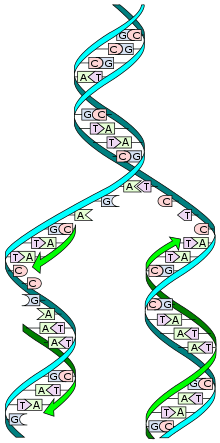Timeline of biotechnology
The historical application of biotechnology throughout time is provided below in order. These discoveries, inventions and modifications are evidence of the evolution of biotechnology since before the common era.
Before Common Era
- 7000 BCE – Chinese discover fermentation through beer making.
- 6000 BCE – Yogurt and cheese made with lactic acid-producing bacteria by various people.
- 4000 BCE – Egyptians bake leavened bread using yeast.[1]
- 500 BCE – Moldy soybean curds used as an antibiotic.
- 250 BCE – The Greeks practice crop rotation for maximum soil fertility.[2]
- 100 CE – Chinese use chrysanthemum as a natural insecticide.[1][3]
Pre-20th Century
- 1663 – First recorded description of living cells by Robert Hooke.
- 1677 – Antonie van Leeuwenhoek discovers and describes bacteria and protozoa.
- 1798 – Edward Jenner uses first viral vaccine to inoculate a child from smallpox.
- 1802 – The first recorded use of the word biology.
- 1824 – Henri Dutrochet discovers that tissues are composed of living cells.
- 1838 – Protein discovered, named and recorded by Gerardus Johannes Mulder and Jöns Jacob Berzelius.
- 1862 – Louis Pasteur discovers the bacterial origin of fermentation.
- 1863 – Gregor Mendel discovers the laws of inheritance.
- 1864 – Antonin Prandtl invents first centrifuge to separate cream from milk.
- 1869 – Friedrich Miescher identifies DNA in the sperm of a trout.
- 1871 – Ernst Hoppe-Seyler discovers invertase, which is still used for making artificial sweeteners.
- 1877 – Robert Koch develops a technique for staining bacteria for identification.
- 1878 – Walther Flemming discovers chromatin leading to the discovery of chromosomes.
- 1881 – Louis Pasteur develops vaccines against bacteria that cause cholera and anthrax in chickens.
- 1885 – Louis Pasteur and Emile Roux develop the first rabies vaccine and use it on Joseph Meister.
20th century''
- 1919 – Károly Ereky, a Hungarian agricultural engineer, first uses the word biotechnology.
- 1928 – Alexander Fleming notices that a certain mould could stop the duplication of bacteria, leading to the first antibiotic: penicillin.
- 1933 – Hybrid corn is commercialized.
- 1942 – Penicillin is mass-produced in microbes for the first time.
- 1950 – The first synthetic antibiotic is created.
- 1951 – Artificial insemination of livestock is accomplished using frozen semen.
- 1952 – L.V. Radushkevich and V.M. Lukyanovich publish clear images of 50 nanometer diameter tubes made of carbon, in the Soviet Journal of Physical Chemistry.
- 1953 – James D. Watson and Francis Crick describe the structure of DNA.
- 1958 – The term bionics is coined by Jack E. Steele.
- 1964 – The first commercial myoelectric arm is developed by the Central Prosthetic Research Institute of the USSR, and distributed by the Hangar Limb Factory of the UK.
- 1972 – The DNA composition of chimpanzees and gorillas is discovered to be 99% similar to that of humans.
- 1973 – Stanley Norman Cohen and Herbert Boyer perform the first successful recombinant DNA experiment, using bacterial genes.[4]
- 1974 – Scientist invent the first biocement for industrial applications.
- 1975 – Method for producing monoclonal antibodies developed by Köhler and César Milstein.
- 1978 – North Carolina scientists Clyde Hutchison and Marshall Edgell show it is possible to introduce specific mutations at specific sites in a DNA molecule.[5]
- 1980 – The U.S. patent for gene cloning is awarded to Cohen and Boyer.
- 1982 – Humulin, Genentech's human insulin drug produced by genetically engineered bacteria for the treatment of diabetes, is the first biotech drug to be approved by the Food and Drug Administration.
- 1983 – The Polymerase Chain Reaction (PCR) technique is conceived.
- 1990 – First federally approved gene therapy treatment is performed successfully on a young girl who suffered from an immune disorder.
- 1994 – The United States Food and Drug Administration approves the first GM food: the "Flavr Savr" tomato.
- 1997 – British scientists, led by Ian Wilmut from the Roslin Institute, report cloning Dolly the sheep using DNA from two adult sheep cells.
- 1999 – Discovery of the gene responsible for developing cystic fibrosis.
- 2000 – Completion of a "rough draft" of the human genome in the Human Genome Project.
21st century
- 2001 – Celera Genomics and the Human Genome Project create a draft of the human genome sequence. It is published by Science and Nature Magazine.
- 2002 – Rice becomes the first crop to have its genome decoded.
- 2003 – The Human Genome Project is completed, providing information on the locations and sequence of human genes on all 46 chromosomes.
- 2008 – Japanese astronomers launch the first Medical Experiment Module called "Kibo", to be used on the International Space Station.
- 2009 – Cedars-Sinai Heart Institute uses modified SAN heart genes to create the first viral pacemaker in guinea pigs, now known as iSANs.
- 2012 – Thirty-one-year-old Zac Vawter successfully uses a nervous system-controlled bionic leg to climb the Chicago Willis Tower.
References
- "Highlights in the History of Biotechnology" (PDF). St Louis Science Center. Archived from the original (PDF) on 23 January 2013. Retrieved 27 December 2012.
- "Agriculture in Ancient Greece". The Ancient History Encyclopedia. Retrieved 27 December 2012.
- "Biotechnology Timeline". Biotechnology Institute of Washington DC. Retrieved 27 December 2012.
- "1973_Boyer". Genome News Network. Retrieved 19 August 2015.
- C A Hutchison, 3rd, S Phillips, M H Edgell, S Gillam, P Jahnke and M Smith (1978). "Mutagenesis at a specific position in a DNA sequence". J Biol Chem. 253: 6551–6560. PMID 681366.CS1 maint: multiple names: authors list (link)
This article is issued from Wikipedia. The text is licensed under Creative Commons - Attribution - Sharealike. Additional terms may apply for the media files.
